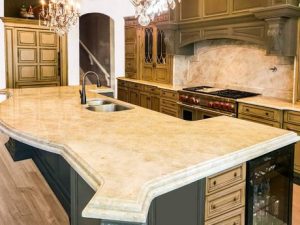If you’re renovating your home or perhaps even building it from scratch, you might be lost in an endless sea of materials and surfaces. Today, we’re here to make your decision easier by assessing the qualities of porcelain for not only sinks but countertops too!
Porcelain Sinks
To start, we’ll look at perhaps the more traditional use of porcelain; sinks. In your kitchen especially, you have a decision to make between porcelain and stainless steel…but which is best?
Well, stainless steel certainly has its merits. We think that it fits most styles, it works with modern appliances in the kitchen, and it’s also easier to clean and keep sterilized. What’s more, it’s a lighter material and therefore easier to install initially. Over time, most people find stainless steel to be the more stain-proof of the two materials and it’s less likely to damage mugs and glasses when accidental contact occurs.

However, a strong percentage of people are choosing porcelain sinks for their kitchens too. Perhaps above all else, it adds a timeless, elegant, and luxurious appearance to the room. Additionally, many homeowners are able to have the same porcelain sink for the duration of their time in the home. With the glossy finish, it makes the room look cleaner and has a nice shine for all those who visit your home.
As time has gone on, the benefits of porcelain have only expanded too. For example, porcelain sinks are now available in a host of different colors. If you want a blue or yellow porcelain sink to match the rest of the kitchen, this is now possible. With stainless steel, some homeowners feel as though it looks too commercial and like something that you’d find in a restaurant kitchen.
Finally, for those with the environment on the mind, we should also note that many manufacturers are producing porcelain sinks using recycled materials. Not only do you get the timeless look, but you also do it while reducing your carbon footprint.
Porcelain Counters
What about porcelain counters? Well, there are many benefits to choosing the material here too. Firstly, compared to the hardest and most durable granite, porcelain is 30% stronger. That’s right, you’ll have a tough surface exactly where you need it most. Even when cooking Thanksgiving dinner with pots and pans flying everywhere, the porcelain allows you to have confidence in the countertop. In fact, we know people who slice food on the counter without a chopping board because of the scratch resistant nature of porcelain (stay away from cutting meats this way!).

Furthermore, porcelain can also endure extreme heats. Again, there’s no worrying about the counter when trying to balance five different pans, baking trays, and hot dishes. At the same time, some sources have porcelain’s water absorption rate at under 0.5%. When a spillage occurs, there’s no need to panic and worry about potential damage.
Elsewhere, porcelain is resistant to stains, non-porous, UV light resistant, available in all sorts of patterns and colors, and environmentally friendly. Considering that it’s made of clay-based and other raw materials, you can recycle the whole countertop when you’re eventually finished with it. Also, we can’t ignore the lightweight nature of porcelain compared to other materials. Just because the material is extremely durable, this doesn’t mean it needs to be extra thick.
Ultimately, porcelain is a fantastic choice for both sinks and counters in the kitchen. Hopefully, you’ve seen why this is the case today. Will you choose it in your kitchen?